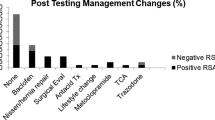Abstract
Background
The prevalence of reflux disease is increasing. Health-care utilization including physician visits for this disorder is lacking. Our purpose was to analyze the trend in physician visits for GERD from the period 1995–2006 using the National Ambulatory Medical Care Survey. We also sought to determine health-care utilization for GERD indirectly by assessing prescription trends for proton-pump inhibitors and H2 receptor blockers during the period.
Methods
The National Ambulatory Medical Care Survey is a survey of approximately 3,000 office-based physicians that uses a three-stage probability sampling procedure to allow extrapolation to the US population. All visits between 1995 and 2006 for symptoms and/or diagnoses compatible with GERD were combined into a single categorical variable. Weighted data was utilized for descriptive and inferential statistical analysis.
Results
After weighting, there were N = 321,513 adult ambulatory care encounters for all diagnoses. Visits for reflux increased throughout the examined period. Using logistic regression, visits for reflux were associated with female gender, age over 40, and calcium channel blocker use. Proton-pump inhibitor use increased substantially during the study period while H2 blocker use declined. Family practitioners and internists saw the majority of reflux patients.
Conclusions
The frequency of ambulatory visits in the United States for gastroesophageal reflux disease increased significantly between 1995 and 2006. The use of PPI therapy is increasing even more substantially. Older age, female gender, and use of calcium channel blockers were associated with a higher frequency of GERD visits. Health-care utilization for this disorder is increasing perhaps due to our ever-increasing epidemic of obesity.

Similar content being viewed by others
References
Klauser AG, Schindlbeck NE, Muller-Lissner SA. Symptoms in gastro-oesophageal reflux disease. Lancet. 1990;335(8683):205–208.
Hirano I, Richter JE. Practice parameters committee of the American College of Gastroenterology. ACG practice guidelines: esophageal reflux testing. Am J Gastroenterol. 2007;102(3):668–685. doi:10.1111/j.1572-0241.2006.00936.x.
Nebel OT, Fornes MF, Castell DO. Symptomatic gastroesophageal reflux: incidence and precipitating factors. Am J Dig Dis. 1976;21:953–956. doi:10.1007/BF01071906.
Kjellen G, Tibbling L. Manometric oesophageal function, acid perfusion test and symptomatology in a 55-year-old general population. Clin Physiol. 1981;1(4):405–415. doi:10.1111/j.1475-097X.1981.tb00908.x.
Thompson WG, Heaton KW. Heartburn and globus in apparently healthy people. Can Med Assoc J. 1982;126(1):46–48.
Ruth M, Mansson I, Sandberg N. The prevalence of symptoms suggestive of esophageal disorders. Scand J Gastroenterol. 1991;26(1):73–81. doi:10.3109/00365529108996486.
Locke GR III, Talley NJ, Fett SL, et al. Prevalence and clinical spectrum of gastroesophageal reflux: a population-based study in Olmsted County, Minnesota. Gastroenterology. 1997;112(5):1448–1456. doi:10.1016/S0016-5085(97)70025-8.
Kuster E, Ros E, Toledo-Pimentel V, et al. Predictive factors of the long-term outcome in gastro-oesophageal reflux disease: six-year follow up of 107 patients. Gut. 1994;35(1):8–14. doi:10.1136/gut.35.1.8.
McDougall NI, Johnston BT, Kee F, et al. Natural history of reflux oesophagitis: a 10-year follow up of its effect on patient symptomatology and quality of life. Gut. 1996;38(4):481–486. doi:10.1136/gut.38.4.481.
Agreus L, Svardsudd K, Talley NJ, et al. Natural history of gastroesophageal reflux disease and functional abdominal disorders: a population-based study. Am J Gastroenterol. 2001;96(10):2905–2914.
Small PK, Loudon MA, Waldron B, et al. Importance of reflux symptoms in functional dyspepsia. Gut. 1995;36(2):189–192. doi:10.1136/gut.36.2.189.
El-Serag HB, Petersen NJ, Carter J, et al. Gastroesophageal reflux among different racial groups in the United States. Gastroenterology. 2004;126(7):1692–1699. doi:10.1053/j.gastro.2004.03.077.
Spechler SJ, Jain SK, Tendler DA, et al. Racial differences in the frequency of symptoms and complications of gastro-oesophageal reflux disease. Aliment Pharmacol Ther. 2002;16(10):1795–1800. doi:10.1046/j.1365-2036.2002.01351.x.
Burt CW, Hing E. Making patient-level estimates from medical encounter records using a multiplicity estimator. Stat Med. 2007;26(8):1762–1774. doi:10.1002/sim.2797.
Castell DO. A practical approach to heartburn. Hosp Pract (Minneap). 1999;34(12):89–94. 97–98.
Avasarala JR, O’Donovan CA, Roach SE, et al. Analysis of NAMCS data for multiple sclerosis, 1998–2004. BMC Med. 2007;5:6. doi:10.1186/1741-7015-5-6.
Balkrishnan R, Sansbury JC, Shenolikar RA, et al. Prescribing patterns for topical retinoids within NAMCS data. J Drugs Dermatol. 2005;4(2):172–179.
Gupta AK, Cooper EA, Feldman SR, et al. A survey of office visits for actinic keratosis as reported by NAMCS, 1990–1999. National Ambulatory Medical Care Survey. Cutis. 2002;70(Suppl(2)):8–13.
Quinn J, McDermott D. Syncope and NAMCS. Acad Emerg Med. 2005;12(4):381. doi:10.1111/j.1553-2712.2005.tb01964.x. Author reply 381–2.
Scholle SH, Chang J, Harman J, et al. Characteristics of patients seen and services provided in primary care visits in obstetrics/gynecology: data from NAMCS and NHAMCS. Am J Obstet Gynecol. 2004;190(4):1119–1127. doi:10.1016/j.ajog.2003.09.059.
Scholle SH, Chang JC, Harman J, et al. Trends in women’s health services by type of physician seen: data from the 1985 and 1997–98 NAMCS. Womens Health Issues. 2002;12(4):165–177. doi:10.1016/S1049-3867(02)00139-1.
Dent J, El-Serag HB, Wallander MA, et al. Epidemiology of gastro-oesophageal reflux disease: a systematic review. Gut. 2005;54(5):710–717. doi:10.1136/gut.2004.051821.
Lagergren J, Bergstrom R, Nyren O. Association between body mass and adenocarcinoma of the esophagus and gastric cardia. Ann Intern Med. 1999;130(11):883–890.
Edelstein ZR, Farrow DC, Bronner MP, et al. Central adiposity and risk of Barrett’s esophagus. Gastroenterology. 2007;133(2):403–411. doi:10.1053/j.gastro.2007.05.026.
Hughes J, Lockhart J, Joyce A. Do calcium antagonists contribute to gastro-oesophageal reflux disease and concomitant noncardiac chest pain? Br J Clin Pharmacol. 2007;64(1):83–89. doi:10.1111/j.1365-2125.2007.02851.x.
Jenkinson LR, Norris TL, Watson A. Gastro-oesophageal reflux associated with nifedipine. Aliment Pharmacol Ther. 1988;2(4):337–339.
Lagergren J, Bergstrom R, Adami HO, Nyren O. Association between medications that relax the lower esophageal sphincter and risk for esophageal adenocarcinoma. Ann Intern Med. 2000;133:165–175.
Locke GR III, Talley NJ, Fett SL, et al. Risk factors associated with symptoms of gastroesophageal reflux. Am J Med. 1999;106:642–649.
Ruigomez A, Wallander MA, Johansson S, et al. Natural history of gastroesophageal reflux disease diagnosed in UK general practice. Aliment Pharmacol Ther. 2004;20:751–760.
Author information
Authors and Affiliations
Corresponding author
Additional information
Previously Published: Friedenberg FK, Nehemia D, Xanthopoulos M, Nelson DB, Richter JE. Prevalence of Gastroesophageal Reflux Disease as Assessed by the National Ambulatory Medical Care Survey. Am J Gastro September 2007 102:S428:A841. Poster Presentation at the 72nd ACG Annual Scientific Meeting, October 2007, Philadelphia, PA.
Rights and permissions
About this article
Cite this article
Friedenberg, F.K., Hanlon, A., Vanar, V. et al. Trends in Gastroesophageal Reflux Disease as Measured by the National Ambulatory Medical Care Survey. Dig Dis Sci 55, 1911–1917 (2010). https://doi.org/10.1007/s10620-009-1004-0
Received:
Accepted:
Published:
Issue Date:
DOI: https://doi.org/10.1007/s10620-009-1004-0




